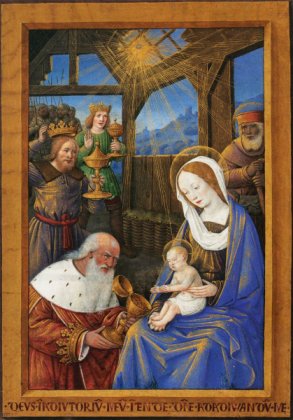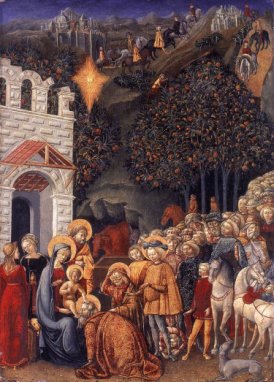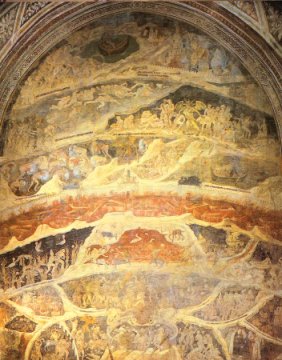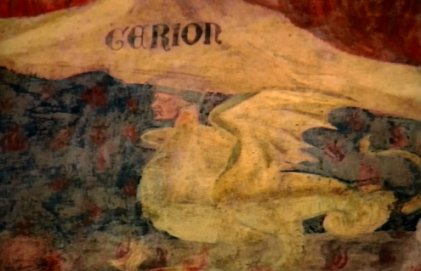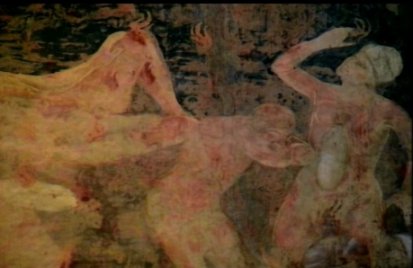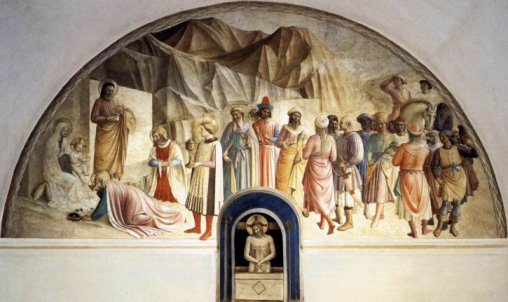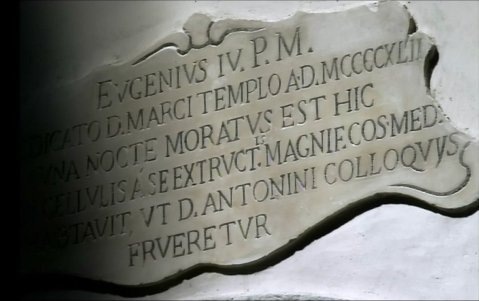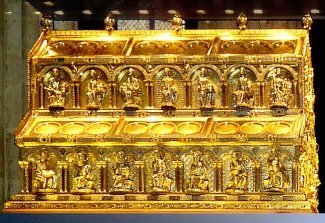|
|
|
|
The star The mosaic from Sant' Appolinaire Nuovo (page 1) shows the Magi following the star. In fact, the star isn't included that often in paintings, possibly because many of them are set in daylight rather than at night. Often, though, there is a particular quality in the lighting of the picture that might suggest a sort of divine illumination. Is the star fact or fiction? This topic has generated much heat over the years, and very little (star)light. Various astronomical possibilities have been raised, such as supernovae, conjunction of planets, and comets. No-one has made any of these fit the appropriate timescale. Others have pointed out the futility of all this - astronomical phenomena just don't behave in the way suggested in the story. The favoured theological explanation is that it refers to this old testament prophecy: 'A star shall rise out of Jacob and a sceptre shall spring up from Israel' (Numbers 24:17) The Catholic encyclopaedia points out that 'star' here is metaphorical rather than literal - star, perhaps, with the modern show-biz meaning. Geza Vermes points out that an astronomical sign signifying a significant birth was a familiar myth at the time the gospel was written. |
|
|
|
|
|
The Magi and Medicis
In the Strozzi chapel in Satan Maria Novella, Florence, is Nado di Cioni’s fresco of Hell, painted in 1350 as Florence struggled to recover from the Black Death. Faded now, it is difficult to make out the individual torments. Dante’s Divine Comedy was the inspiration for the work, and it can help decipher it. There, in the seventh circle, we find the sodomites and usurers. This is Dante's description of them: . . .this way and that they flapped their hands, for ease From the hot soil now, and now from the burning snow, Behaving, in fact exactly as one sees Dogs in the summer, scuffing with snout and paw, When they're eaten up with breezes and flies and fleas. (Divine Comedy: Hell. Canto XVII Trans.Dorothy L. Sayers) Note: why link usurers and sodomites? Because, according to Dorothy Sayers, both activities actually produce nothing. |
|
|
|
|
|
|
|
|
His most important project, at the behest of Pope Eugenius IV, was the Church and convent of San Marco in Florence. To my mind, The Dominican convent of San Marco is the most beautiful and moving location in Florence. There are over thirty cells, each one with a fresco by Fra Angelico or one of his assistants. Cell 39 was the private space of Cosimo – here he prayed and meditated. And on the wall of his cell was an image of The Adoration of the Magi. |
|
|
|
|
|
We have already seen
Gozzoli’s Journey of the Magi in the chapel at the Medici Place. The
family were the leading lights of the Compania dei Magi, also called
'Confraternity of the Star'. So why were the Magi important to the Medici? |
|
|
|
|
|
|
|
|
Would it work? I don’t think Dante would think so. 140 years earlier, a moneylender – Enrico Scrovegni – has spent a large amount of money on a chapel in Padua; famous, of course, for its frescos by Giotto. He was hoping to make amends for his father, Rinaldo dei Scrovegni, another unscrupulous usurer. Here he is, depicted by Giotto, handing over his chapel to grateful angels, and an image of the Hell he hoped to rescue his father from. But read The Inferno, and there you will find poor old Rinaldo still there in the burning sand, along with all those sodomites. Maybe Enrico managed to get away with it, though. |
|
|
|
|
|
Where are they now? Below is the gold reliquary of the Magi in the Cathedral at Cologne.The story of how they got there is a complicated one. Saint Helena apparently found them on her journey to Palestine, though what they were doing there isn't clear. Supposedly, she took them back to Constantinople and enshrined them in Hagia Sophia. Eustorgius, Bishop of Milan, translated them to Milan in 343. From there they journeyed on to Cologne in 1164. Not everyone agrees that it's really them. Marco Polo claimed to have seen the tombs of the Magi in the Persian town of Saveh south of Tehran around 1270. |
|
|
|
|
|
|
|
